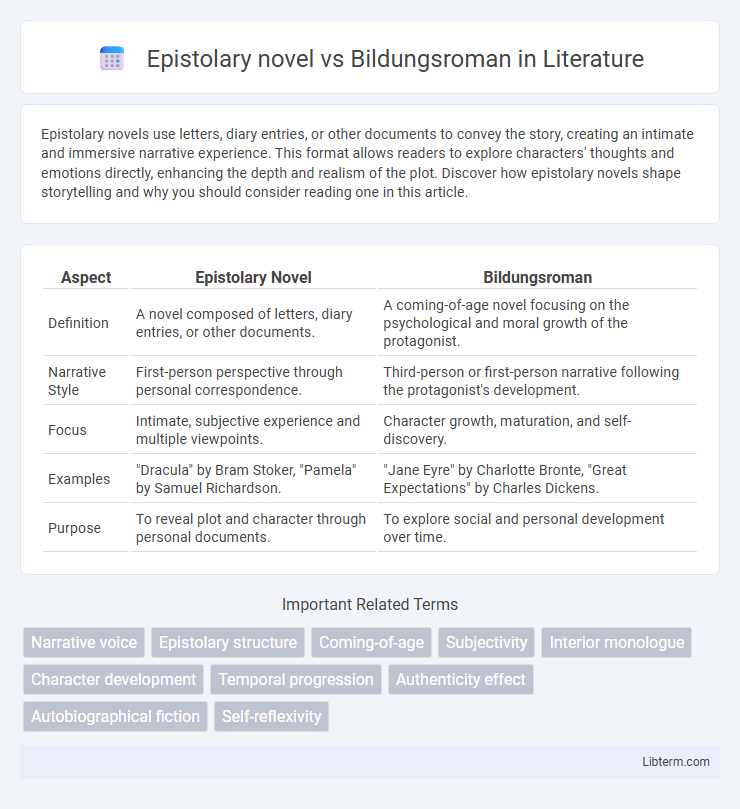Epistolary novels use letters, diary entries, or other documents to convey the story, creating an intimate and immersive narrative experience. This format allows readers to explore characters' thoughts and emotions directly, enhancing the depth and realism of the plot. Discover how epistolary novels shape storytelling and why you should consider reading one in this article.
Table of Comparison
| Aspect | Epistolary Novel | Bildungsroman |
|---|---|---|
| Definition | A novel composed of letters, diary entries, or other documents. | A coming-of-age novel focusing on the psychological and moral growth of the protagonist. |
| Narrative Style | First-person perspective through personal correspondence. | Third-person or first-person narrative following the protagonist's development. |
| Focus | Intimate, subjective experience and multiple viewpoints. | Character growth, maturation, and self-discovery. |
| Examples | "Dracula" by Bram Stoker, "Pamela" by Samuel Richardson. | "Jane Eyre" by Charlotte Bronte, "Great Expectations" by Charles Dickens. |
| Purpose | To reveal plot and character through personal documents. | To explore social and personal development over time. |
Introduction to Epistolary Novels and Bildungsromans
Epistolary novels, defined by their use of letters, diary entries, or other personal documents, offer intimate insights into characters' thoughts and emotions, creating a multifaceted narrative perspective. Bildungsroman, a German term meaning "novel of formation," centers on the psychological and moral growth of the protagonist from youth to adulthood, charting a journey of self-discovery and personal development. Both genres emphasize character depth and emotional resonance but differ in narrative structure; epistolary novels depend on fragmented, first-person accounts, while Bildungsromans follow a cohesive, developmental storyline.
Defining the Epistolary Novel
The epistolary novel is defined by its narrative structure, which unfolds through letters, diary entries, or other personal documents that allow for intimate character perspectives and fragmented storytelling. This format emphasizes emotional depth and subjective experience, often creating a sense of immediacy and authenticity in the reader's engagement. Unlike the Bildungsroman, which centers on the protagonist's psychological and moral growth over time, the epistolary novel prioritizes the presentation of multiple voices and varied viewpoints through written correspondence.
Understanding the Bildungsroman Genre
The Bildungsroman genre centers on the psychological and moral growth of the protagonist from youth to adulthood, emphasizing character development and personal maturation. Unlike the epistolary novel, which tells a story through letters or diary entries providing multiple perspectives, Bildungsromans employ a linear narrative to explore identity formation and societal integration. Key examples include Goethe's *Wilhelm Meister's Apprenticeship* and Charlotte Bronte's *Jane Eyre*, which highlight the protagonist's journey toward self-awareness and social belonging.
Historical Origins and Evolution
Epistolary novels originated in the 17th century, characterized by narratives conveyed through letters, allowing intimate insights into characters' thoughts and social contexts, with seminal examples like Samuel Richardson's "Pamela" (1740). Bildungsroman, emerging prominently in the late 18th century Germany, focuses on the psychological and moral growth of the protagonist, as seen in Goethe's "Wilhelm Meister's Apprenticeship" (1795-96), highlighting individual development and self-discovery. Both genres evolved through the 19th century, with epistolary form adapting to new media while Bildungsroman deepened its exploration of identity and societal roles.
Narrative Structure: Letters vs. Coming-of-Age
Epistolary novels employ a narrative structure composed entirely of letters, allowing readers intimate access to characters' thoughts and emotions through personal correspondence. Bildungsroman, or coming-of-age novels, focus on the protagonist's psychological and moral growth over time, typically following a linear narrative arc. The contrast lies in epistolary's fragmented, first-person perspectives versus bildungsroman's cohesive, developmental storyline centered on maturity and self-discovery.
Character Development in Both Genres
Epistolary novels use letters or diary entries to reveal characters' emotions and thoughts gradually, allowing readers to witness intimate personal growth with a strong sense of immediacy and authenticity. Bildungsroman focuses on the protagonist's psychological and moral growth from youth to adulthood, emphasizing a transformative journey shaped by life experiences and societal challenges. Both genres deeply explore character development but through different narrative structures--epistolary offers fragmented, subjective insights, while Bildungsroman presents a cohesive, chronological progression.
Themes Explored: Introspection and Growth
Epistolary novels delve into introspection through personal letters, revealing character emotions and internal conflicts with authentic voice and intimate perspective. Bildungsroman narratives emphasize growth by chronicling the protagonist's journey from youth to maturity, highlighting psychological development and moral challenges. Both genres explore identity and self-realization, yet the epistolary form foregrounds subjective experience while the Bildungsroman structures transformation within a broader social context.
Reader Engagement and Perspective
Epistolary novels engage readers through intimate, first-person accounts, creating a direct emotional connection as they experience characters' thoughts and feelings via letters or diary entries. Bildungsroman narratives captivate audiences by chronicling a protagonist's psychological and moral growth, offering a broader perspective on life's challenges and societal roles. While epistolary forms provide immediacy and personal insight, bildungsromans maintain a developmental arc that fosters empathy through evolving identity and self-awareness.
Notable Examples from Literature
Notable examples of epistolary novels include Bram Stoker's *Dracula* and Mary Shelley's *Frankenstein*, both using letters and diary entries to enhance narrative intimacy and multiple perspectives. In contrast, Bildungsroman classics like Johann Wolfgang von Goethe's *Wilhelm Meister's Apprenticeship* and Charlotte Bronte's *Jane Eyre* focus on the protagonist's psychological and moral growth from youth to adulthood. Each genre uniquely captures personal transformation, with epistolary novels emphasizing fragmented storytelling through correspondence, while Bildungsroman novels chronicle a continuous developmental journey.
Comparative Analysis: Impact on Modern Fiction
Epistolary novels, characterized by their use of letters or diary entries, create an intimate, multi-perspective storytelling style that influences modern fiction by fostering deep emotional engagement and fragmented narratives. Bildungsroman focuses on the psychological and moral growth of the protagonist, shaping character-driven plots that emphasize personal development and identity formation in contemporary literature. The combination of epistolary intimacy and bildungsroman's developmental arc enriches modern fiction by blending emotional depth with transformative character journeys.
Epistolary novel Infographic

 libterm.com
libterm.com